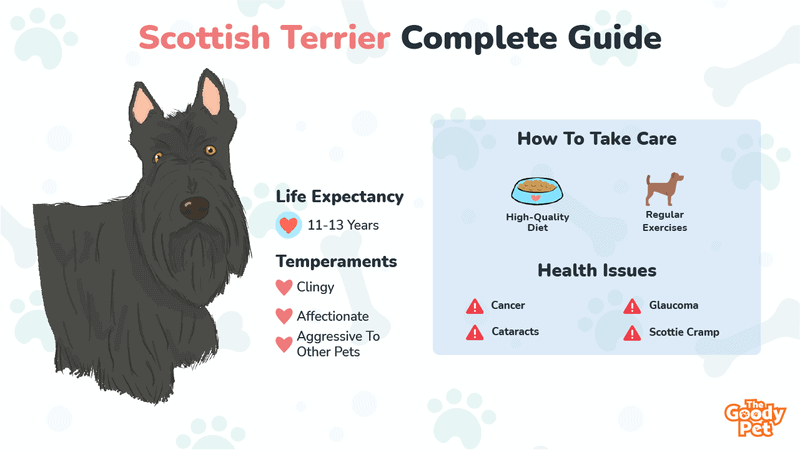Being a pet parent since 2016, I have learned that dog breeds differ vastly in needs, size, behavior, and looks. You may recognize this famous breed since three different U.S. presidents had Scottish Terriers. These Scottie pets are also famous for their appearance in Lady and the Tramp and as a game piece in Monopoly. So, what is a Scottish Terrier?
Popularly known as “Scotties,” the Scottish Terrier is an independent and strong-willed dog breed. It is a small, sturdily built terrier with short legs and a wiry outer coat. While Scotties form strong attachments with people, they are wary of strangers. Due to their strong hunting instinct, Scotties often chase animals they perceive as prey (even larger dogs). So, it’s best to keep this cantankerous pooch on a leash.
Scotties make excellent pets. You need to be fully informed about the Scottish Terrier breed if you are, or are thinking of becoming, a Scottie parent. This article highlights information regarding your four-legged furry friend’s lifespan, health concerns, care and grooming tips, and temperament. Before that, I’ll discuss their physical characteristics in detail.
How Big Do Scottish Terriers Get?

Most canines vary in size, so dog parents may wonder how big a Scottish Terrier doggie becomes.
Physical Appearance
The Scottish Terrier’s height ranges from 9.8 inches to 11 inches. Regarding weight, females differ slightly from males. Females weigh between 18 to 21 lbs. Male Scotties weigh between 19 to 22 lbs.
Scottish Terriers are well-known for their small, bright, and piercing eyes that range in color from black and gray-black to white. Scotties also have a distinctively erect tail and thin ears that stand up straight.
Is A Scottie Dog A Schnauzer?
A Scottie dog is not a Schnauzer. The Miniature Schnauzer is similar in size to a Scottie but slightly taller, measuring between 12 to 14 inches. Schnauzers may weigh less than a Scottie, with weights between 11 to 20 lbs. Also, a Schnauzer doesn’t have short legs.
Coat Colors And Patterns
Scottie canines are well-known for their wiry and hard coat, which is also weather resistant. They are classified as a wiry-coated breed. They have thick fur that hangs gracefully between the doggie’s short, heavy legs. The doggie’s fur coat is smoother at the beard, legs, and lower body but not fluffy.
Scottie’s fur color ranges from grayish-black to black and even white. Often black and brindle-coated Scotties may have white or silver specks patterns on their fur. It’s easy to mistake a White-coated Scottish Terrier for a West Highland White Terrier or a Soft-coated Wheaten Terrier.
How Long Do Scottish Terriers Live?

Scottish Terriers have a lifespan between 11 to 13 years. Several health conditions affect Scotties as they age, which we are discussing next.
Common Health Issues That Affect Scotties
Other than parasites and mange common to every dog breed, Scottish Terriers don’t typically suffer from other specific skin conditions. However, these four-legged furry friends become prone to eye problems, such as glaucoma and cataracts, as they age.
We also list other common health issues that affect Scotties below:
Cancer In Scottish Terriers
The Scottish Terriers’ chances of developing cancer are higher when compared to pure dog breeds. Scotties are highly vulnerable to urinary tract cancers such as transitional cell carcinoma and bladder cancer.
The following cancer types also affect Scotties: nasal carcinoma, squamous cell carcinoma, gastric carcinoma, and malignant melanoma.
Scottie Cramp
“Scottie cramp” is a hereditary neuromuscular disorder in Scotties, meaning that if your dog suffers from the disease, avoid breeding it. Vets diagnose such cramps through complete blood count, physical observation, urinalysis, and biochemistry.
Symptoms include over-flexing the rear legs, arching the back, and pushing of front legs to the side. This may cause your canine buddy to fall if moving at high speed. The canine, however, remains conscious and such symptoms tend to occur when your pooch is under stress.
Craniomandibular Osteopathy
Usually experienced between the ages of 4 and 7 months, craniomandibular osteopathy causes excessive growth of the lower jawbone in Scotties. Excessive growth may cause strenuous chewing as your furry friend eats. This condition typically ends between the ages of 11 to 13 months.
How To Take Care Of Your Scottish Terrier?
There are several important aspects to take note of when it comes to caring for your Scottish Terriers. They can range from diet to dental care. Let’s look at them in this section.
The Exercise Routine
Scottish Terriers need up to an hour’s walk or exercise routine since they are rather active. It is advisable to walk them on a leash as they are easily distracted by animals that strike them as prey. Scotties also require a high-quality diet and multivitamins to maintain a healthy lifestyle.
High-Quality Diet For Scottish Terriers
How many cups of food do Scottish Terriers need in a day? The recommended amount is between 1 to 1½ cups of high-quality dry diet food per day.
However, the amount can differ according to the age, size, and metabolism of your Scottie. Scottish Terriers take ½ to 1 oz of water per pound of weight every day.
Multivitamins
Do Scottish Terriers need multivitamins? If your Scottie feeds on commercial foods, it will not need multivitamins unless a vet recommended them. However, Scotties fed on homemade foods may require supplements to make sure they are getting enough vitamins.
Pet Plate
Pet Plate makes high-quality, highly nutritious meals prepared in USDA kitchens with human-grade ingredients for your furry friend. Pet Plate’s main goal is to make food that ensures doggies live a long, healthy, and happy life. Pet Plate creates fresh dog food from whole ingredients, such as apples, pumpkins, and chicken.
Dental Water Additives
Is it safe to use dental water additives in your Scottie’s water bowl? When you use dental water additives in your furry friend’s water bowl, it helps prevent plaque and tartar. Add dental water additives to the water bowl daily.
Are Scottish Terriers Affectionate?
Strangers may have a challenging time gaining affection from Scotties since the canines become wary around new faces. Scottish Terriers are, however, very affectionate toward familiar faces. Scotties are known to trust people with a pure heart, but unlike other dog breeds, you can’t gain their affection with treats.
Are Scottish Terriers Good Pets?
Scottish Terriers are not good pets for families with very small children and can be very picky about who they interact with. They are, however, good pets for adults who live alone or have grown children who can treat Scottish Terriers nicely.
Known to be extremely aggressive towards other pets, Scotties deserve a home without other pets.
They also don’t demand a great amount of affection, making them an excellent choice for dog lovers who have multiple chores around the house.

Are Scottish Terriers Hard To Train?
Scottish Terriers are difficult to train since they are naturally inclined to guide themselves. They hardly ask for their owner’s directions or permission, unlike other canine breeds.
They are also emotionally sensitive, which does not go hand in hand with aggressive training. However, this doesn’t mean that you can’t train Scottie. It means training requires a lot of time and patience.
Can Scottish Terriers Be Left Alone?
Scottish Terriers can be left alone for a few hours but no longer than 8 hours since they are not a needy breed. However, they require a lot of care and positive feedback since they are so sensitive. It would be best if you restrained from punishing or scolding, for the doggy’s emotional wellness.
Are Scottish Terriers High-Maintenance? Grooming Tips For Scottish Terriers
Scotties need a lot of maintenance to keep them clean and neat. Your Scottie’s grooming schedule, however, depends on whether they are hand-stripped or clipped. Ideally, for a stripped Scottish Terrier, your furry friend will require regular grooming every week.
If you prefer clipping your Scottie, a routine grooming schedule every 4 to 6 weeks will give you an excellently happy canine friend.
Are Scottish Terriers Hypoallergenic?
Scottish Terriers are hypoallergenic since they neither drool nor shed. This makes them a perfect match for allergic people since they do not cause flare-ups.
If you are allergic to dogs but need a furry friend with a spice of attitude and bravery, a Scottie is the best match for you! You will, however, need to maintain regular grooming to ensure your Scottie stays hypoallergenic.
Use an undercoat brush or the FURminator Undercoat Tool to effectively remove loose hair without cutting your canine buddy’s skin.
Why Does My Scottish Terrier Smell?
Suppose your Scottish Terrier smells even after bathing. In that case, there is a high probability your doggy may be suffering from a skin infection, an allergy, a bacterial infection, or a yeast infection.
Scottish Terrier doggies smell if their coats are not well maintained. Due to the wiriness of their fur, they require special dog shampoos that easily detangle fur, making bathing easier. As both a doggy owner and trainer, we use Paws & Pals 6-In-1 Oatmeal Dog Shampoo.
This shampoo detangles my doggy’s fur coat while relieving allergy symptoms, leaving my pooch itch-free and deodorizing its coat, leaving behind a fresh smell.
Related Questions
How Much Do Scottish Terriers Cost? Scottish Terriers cost between $1,000 and $1,500 in the United States if you buy from a reputable brand. Purebred Scotties, on the other hand, go for as high as $3,000. The price varies depending on the breeder you choose.
Are There Miniature Scottish Terriers? Yes, there are Miniature Scottish Terriers for dog lovers who love small furry friends. They weigh less than 15 lbs and only grow up to 11 inches tall. Mini Scottish Terriers have dense, flat, wiry coats and are a perfect choice for canine lovers who live in apartments.
Do Scottish Terriers Swim? Scottish Terriers struggle with swimming because of their short legs and body weight. Like all dogs, Scotties can naturally swim for only a brief period before tiring out. If you plan to take your doggie for a swim, we advise using a life vest for safety purposes.





